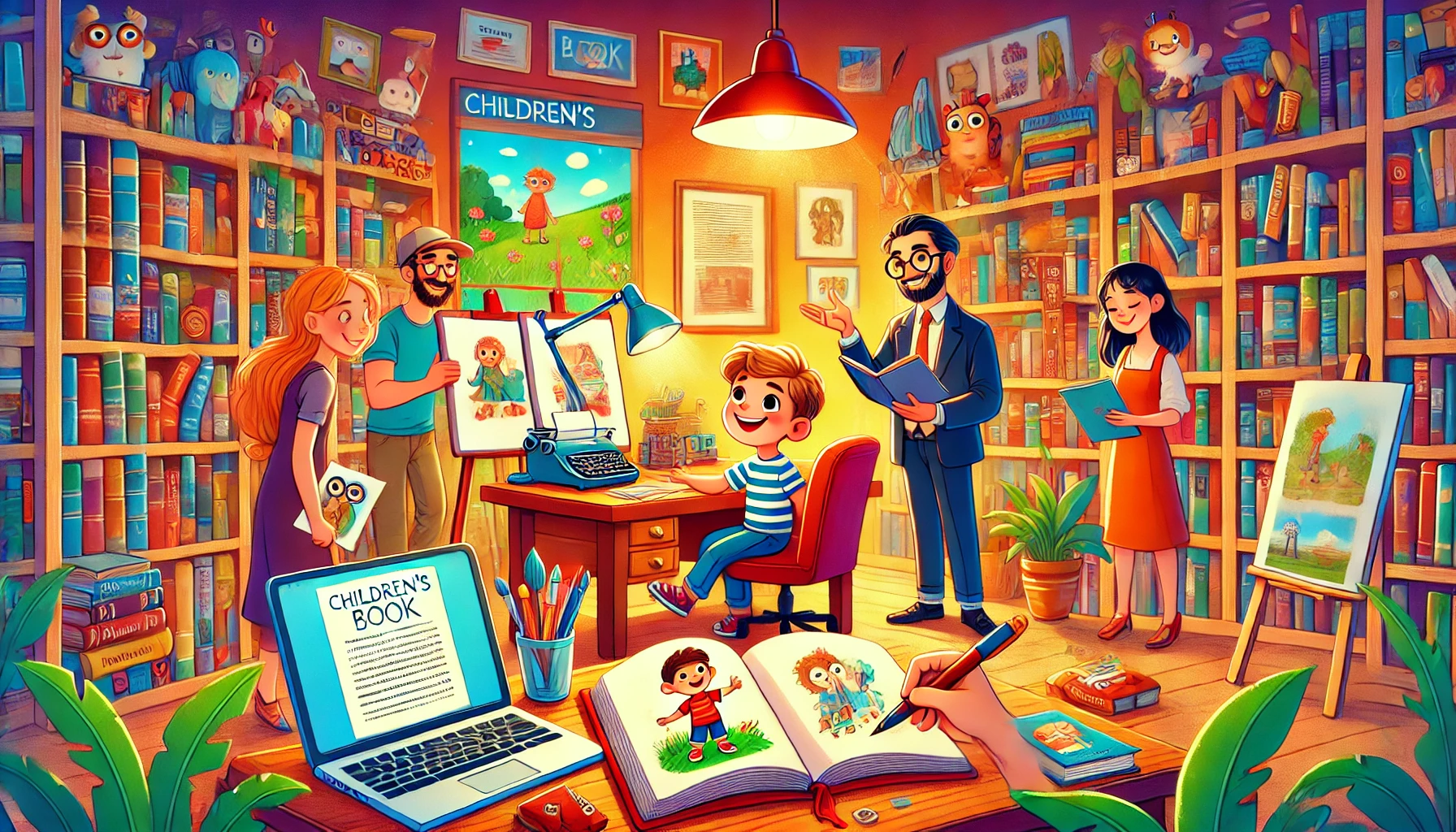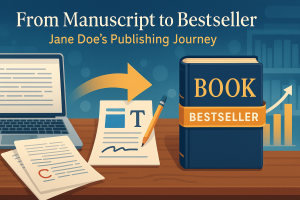Publishing a children’s book is an exciting, rewarding journey that takes creativity, persistence, and a solid strategy. Whether you’re writing a picture book for toddlers, a middle grade adventure, or a young adult story, understanding the ins and outs of the publishing process is essential. In this comprehensive guide, we’ll walk you through everything from crafting your manuscript to navigating the world of traditional and self-publishing. We’ll cover key topics like working with a publishing company, finding the right literary agent, designing an engaging book cover, and planning school visits to promote your work. Our goal is to provide actionable steps, insider tips, and useful resources so that you can join the ranks of a published author with a published book that resonates with children of all ages.
In this article, we will explore:
- The essentials of writing a children’s book
- Choosing the right genre and format—from board books to picture books
- Tips for creating engaging characters and storylines
- The debate: Traditionally published vs. self-publishing
- How to work with Book Publishing Services and other professionals
- Marketing strategies, including school visits and online promotion
- A step-by-step guide to the publishing process
Let’s explore the secrets of successfully publishing a children’s book.
Understanding Your Audience
Who Are You Writing For?
Before you begin writing, it’s crucial to understand who your target audience is. Children’s literature spans various age groups and interests:
- Board Books: Ideal for infants and toddlers. These books are durable and feature simple illustrations and text.
- Picture Books: Targeted at preschoolers and early readers. They combine vivid illustrations with engaging narratives.
- Middle Grade: Written for children ages 8-12, these stories often involve more complex plots and character development.
- Young Adult: Although these are aimed at teens, some themes can also be adapted for mature middle grade readers.
Each category has its own style, tone, and content expectations. As you plan your story, consider what age group you’re writing for and tailor your language, plot complexity, and themes accordingly.
Why Children’s Books Matter
Children’s books are not only a source of entertainment but also a tool for learning and growth. They help young readers develop language skills, emotional intelligence, and empathy. A great book for children can inspire a lifelong love for reading and ignite curiosity about the world. The power of storytelling in early education cannot be underestimated, and as a writer, you have the opportunity to make a lasting impact.
Creating Your Story
Ideation and Concept Development
Every successful book starts with a compelling idea. Begin by brainstorming concepts that excite you and that you believe will resonate with children. Consider the following tips:
- Draw from Experience: Think about your own childhood, family traditions, or memorable school visits.
- Explore Themes: Focus on universal themes like friendship, adventure, overcoming fears, and self-discovery.
- Embrace Diversity: Aim for stories that celebrate diversity and inclusion. Children’s books should represent various cultures, backgrounds, and experiences.
- Keep It Fun: Whether it’s humor, fantasy, or adventure, the narrative should be engaging and enjoyable for your readers.
Developing Characters and Plot
Characters are the heart of your story. Develop characters that are relatable, dynamic, and capable of growth. Consider the following:
- Protagonists and Sidekicks: Create a memorable main character along with supportive characters that add depth to the narrative.
- Villains and Challenges: Even in children’s literature, a well-crafted antagonist or challenge helps propel the story forward.
- Conflict and Resolution: Introduce conflicts that are age-appropriate and provide satisfying resolutions that offer learning moments.
For instance, if you’re writing a picture book, the plot might be simple and revolve around a day in the life of a quirky animal or a child experiencing a magical event. In contrast, a middle grade novel might involve a more intricate journey where the protagonist overcomes significant obstacles or embarks on a quest.
Incorporating Illustrations
In children’s books, illustrations are not just decorations—they are an integral part of storytelling. Collaborate with an illustrator if you are not an artist yourself. Here are some considerations:
- Style and Tone: Ensure that the art style matches the tone of your narrative. A whimsical story may benefit from vibrant, colorful illustrations, whereas a more serious tale might use a subdued palette.
- Page Layout: Plan how text and illustrations will coexist on each page. Balance is key; too much text can overwhelm young readers, while too many images may distract from the narrative.
- Consistency: Maintain consistency in characters, settings, and colors throughout the book.
The Writing Process
Drafting Your Manuscript
Once your concept is clear, it’s time to put pen to paper. Here are steps to guide you through drafting your manuscript:
- Outline Your Story: Create a detailed outline of the plot, chapter by chapter or page by page. This helps you maintain structure and ensures that every part of the story contributes to the overall narrative.
- Write a Rough Draft: Begin writing without worrying too much about perfection. Your first draft is about getting your ideas down.
- Revise and Edit: After completing your rough draft, take time to revise. Look for ways to improve character development, pacing, and clarity. Consider feedback from peers or a writing group.
- Polish Your Language: Pay attention to word choice, sentence structure, and dialogue. Remember that the language should be accessible for your intended age group.
Editing and Feedback
Editing is a critical step in publishing a children’s book. Hiring a professional editor who specializes in children’s literature can be very beneficial. They can help you with:
- Grammar and Syntax: Ensuring that your manuscript is error-free and flows well.
- Content Appropriateness: Checking that the themes, language, and content are suitable for the age group.
- Pacing and Structure: Helping you refine the story so that it maintains a good rhythm and keeps young readers engaged.
Additionally, consider hosting reading sessions with children, parents, or educators. Their feedback can offer invaluable insights and help you tailor your story for your audience.
The Design Phase
Creating a Captivating Book Cover
The cover of your children’s book is the first thing a potential reader will see. A great book cover can make a significant impact on sales and reader engagement. Here are some tips for designing a memorable cover:
- Reflect the Story: The design should capture the essence of your narrative and resonate with the target audience.
- Use Bold Colors: Vibrant colors can attract attention, especially on shelves or online listings.
- Hire a Professional: If you’re not a designer, consider hiring someone with experience in children’s book covers.
- Test Your Design: Share different cover options with friends, family, or focus groups to gather feedback before finalizing.
Interior Layout and Illustration Placement
The interior design of your book is just as important as the cover. Here’s how to ensure your layout is engaging:
- Font Selection: Choose fonts that are easy to read for children. Avoid overly decorative fonts that might distract or confuse early readers.
- Text and Image Balance: Create a layout that seamlessly integrates text with illustrations. Ensure that the images complement the narrative rather than overpower it.
- White Space: Use white space effectively to prevent clutter and make the pages more inviting.
- Consistent Style: Ensure that the style of illustrations remains consistent throughout the book for a cohesive look.
Traditional Publishing vs. Self-Publishing
One of the most critical decisions you’ll face is choosing between traditional publishing and self-publishing. Each path has its pros and cons, and the best option depends on your personal goals, resources, and timeline.
Traditional Publishing
Traditional publishing involves partnering with a publishing company that takes on the responsibility of editing, designing, distributing, and marketing your book. Here are some advantages:
- Credibility and Prestige: Being a published author with a traditionally published book can carry significant weight in the market.
- Professional Support: You have access to experienced professionals, including editors, designers, and marketers, who can help elevate your book.
- Wider Distribution: Traditional publishers often have established networks that can help your book reach a broader audience, including libraries, bookstores, and international markets.
However, the traditional route can be competitive and time-consuming. You might need to secure a literary agent before approaching publishers, and the process can involve multiple rounds of rejection before acceptance.
For authors considering traditional avenues, learning about available Book Publishing Services can provide insight into professional standards and expectations. You can explore options and gain valuable perspectives on the benefits of partnering with established publishers.
Self-Publishing
Self-publishing has become increasingly popular due to advancements in digital printing and online distribution. It offers several advantages:
- Creative Control: You retain full control over the content, design, and marketing strategies.
- Faster Time-to-Market: Once your manuscript is ready, you can publish your book without waiting for traditional gatekeepers.
- Higher Royalties: With self-publishing, you typically earn a larger percentage of each sale.
There are challenges, however. Self-publishing requires you to manage multiple aspects of the process, such as cover design, formatting, distribution, and promotion. It’s essential to research platforms like Amazon’s self-publishing tools and associated costs. If you’re considering this path, understanding Amazon Self-Publishing Cost structures and the nuances of Amazon Book Publishing can help you make informed decisions.
Both publishing paths require dedication and strategic planning. Some authors choose to start with self-publishing to build their audience and later transition to traditional publishing, while others go straight for a traditional deal. Evaluate your goals, budget, and timeline carefully to decide which route suits you best.
Navigating the World of Literary Agents and Publishing Companies
Finding the Right Literary Agent
A literary agent can be a valuable partner in your publishing journey, especially if you’re aiming for traditional publishing. Agents help refine your manuscript, negotiate contracts, and connect you with reputable publishing houses. Here’s how to find one:
- Research and Referrals: Look for agents who specialize in children’s literature. Many authors share their experiences on blogs and in interviews.
- Submission Guidelines: Follow each agent’s submission guidelines carefully. Tailor your query letter and sample chapters to meet their expectations.
- Attend Conferences: Writing conferences and workshops provide opportunities to network with agents and gain insights into the industry.
Remember, the right agent will believe in your vision and work tirelessly to help you secure the best deal possible.
Evaluating Publishing Companies
If you decide to work directly with a publishing company, it’s important to choose one that aligns with your vision and goals. Some companies are dedicated exclusively to children’s literature, while others offer a broader range of titles. Consider factors such as:
- Reputation and Track Record: Look for companies that have successfully launched children’s books similar to yours.
- Marketing and Distribution: A robust marketing plan and distribution network can significantly boost your book’s visibility.
- Contract Terms: Understand your rights as an author, including royalties, reversion clauses, and distribution territories.
Exploring reputable Book Publishing Services can provide further guidance on how to evaluate your options and select a partner that will champion your book.
Marketing Your Children’s Book
Building an Online Presence
In today’s digital age, having an online presence is critical for any author. Start by creating a professional website and engaging on social media platforms to build your brand. Here are some actionable tips:
- Author Website: Include a blog where you share insights into your writing process, behind-the-scenes looks at your book’s creation, and updates on upcoming projects.
- Social Media: Use platforms like Instagram, Facebook, and Twitter to connect with readers, share illustrations, and promote events such as school visits.
- Email Marketing: Develop an email list to keep your audience updated on new releases, promotional offers, and exclusive content.
Leveraging Internal and External Links
Internal linking is a powerful SEO strategy that not only boosts your website’s ranking but also provides your readers with additional valuable content. For example, you can naturally integrate links like Book Publishing Services into discussions about traditional publishing options. Additionally, sharing insights on marketing can be enhanced by referencing articles like How to Market Your Own Book. Utilizing these internal links helps create a cohesive ecosystem of content that benefits both your readers and your site’s search ranking.
Offline Marketing Strategies
Don’t overlook the power of offline marketing. Here are some effective strategies to promote your children’s book:
- School Visits and Readings: Organize visits to local schools and libraries. Interactive sessions can create a buzz and encourage word-of-mouth promotion among parents and educators.
- Book Fairs and Festivals: Participate in book fairs and literary festivals. These events offer excellent opportunities to network with other authors, educators, and industry professionals.
- Local Media: Reach out to local newspapers, radio stations, and community blogs. A well-crafted press release can generate local interest and support for your book.
Embracing Digital Marketing
Digital marketing offers many avenues to reach a global audience. Consider the following:
- Content Marketing: Write blog posts about topics related to writing, publishing, and the creative process. This not only establishes you as an expert in the field but also helps improve your website’s SEO.
- Paid Advertising: Platforms like Google Ads and Facebook Ads allow you to target specific demographics. You might run campaigns that focus on parents, educators, or librarians.
- Video Content: Create videos that share your writing journey, offer book readings, or explain the publishing process. Platforms like YouTube and TikTok can help you reach a wider audience.
- Partnerships: Collaborate with influencers in the children’s book space. Their endorsements can significantly boost your book’s credibility and reach.
For detailed insights on costs associated with self-publishing and digital marketing on major platforms, check out guides like Amazon Self-Publishing Cost and Amazon Book Publishing.
Self-Publishing: A Step-by-Step Guide
If you decide to self-publish your children’s book, there are several key steps to follow. Here’s a detailed roadmap:
Step 1: Finalize Your Manuscript and Illustrations
Before you move forward, ensure that your manuscript is thoroughly edited and your illustrations are complete. This might involve multiple rounds of revisions and feedback from beta readers, educators, or professional editors. Keep in mind that attention to detail is critical in children’s literature, where both narrative and visual elements must work harmoniously.
Step 2: Format Your Book for Print and Digital Platforms
Proper formatting is essential for both print and digital editions. Use professional software or hire a formatting specialist to:
- Ensure Consistency: Maintain uniform margins, font sizes, and spacing.
- Optimize for eBooks: Adjust layout settings so that your text and images display correctly on various devices.
- Prepare Print Files: Adhere to the printing guidelines of your chosen platform, ensuring that your pages are properly set up for binding and quality reproduction.
Step 3: Choose a Publishing Platform
There are numerous platforms available for self-publishing. Research and select the one that best suits your needs, taking into account:
- Distribution Reach: Platforms like Amazon Kindle Direct Publishing (KDP) offer vast distribution channels.
- Royalty Rates: Understand the revenue model and compare royalty rates across platforms.
- Ease of Use: Consider the user interface and support provided by the platform.
Step 4: Design a Marketing Plan
A well-thought-out marketing plan is as important as the book itself. Plan your launch strategy, which may include:
- Pre-Launch Campaigns: Generate buzz through social media teasers, blog posts, and email newsletters.
- Launch Events: Organize virtual or in-person events, such as book readings or signing sessions.
- Post-Launch Activities: Engage with your readers through follow-up events, Q&A sessions, or interactive online content.
Step 5: Monitor Your Sales and Gather Feedback
After publication, monitor your book’s performance across various platforms. Use analytics to track sales, reviews, and reader engagement. Feedback is crucial—both positive and constructive critiques can guide your future projects and help you refine your approach.
Tips from Experienced Authors
Learn from the Pros
Many published authors of children’s books have valuable insights to share. Here are a few tips gleaned from industry experts:
- Perseverance Pays Off: Rejections are part of the process. Keep refining your work and submitting your manuscript.
- Network: Attend writing conferences and join online communities to connect with fellow authors, illustrators, and industry professionals.
- Be Open to Feedback: Constructive criticism can enhance your storytelling and help you see your work from different perspectives.
- Stay Informed: The publishing industry is constantly evolving. Stay updated on trends, especially with the rise of digital publishing and self-publishing opportunities.
Engage with Your Community
As you develop your career as an author, consider organizing school visits and community events. These interactions not only promote your book but also offer a chance to inspire the next generation of readers. By engaging with educators and young readers, you build a supportive community that can provide lifelong fans and advocates for your work.
Overcoming Common Challenges in Publishing a Children’s Book
Navigating Rejection and Criticism
Every writer faces rejection at some point. Instead of taking it personally, use it as a learning opportunity. Rejections from publishers or literary agents can help you refine your work further. Embrace criticism and continuously work on improving your manuscript. Remember, every published book was once a rough draft that underwent multiple revisions.
Balancing Creativity and Market Demands
Striking a balance between creative storytelling and marketability can be challenging. While it’s important to stay true to your vision, understanding market trends and reader preferences is crucial. Study best-selling children’s books in various categories—whether it’s board books, picture books, or middle grade novels—to see what resonates with your target audience. This insight can help you tweak your story without compromising its uniqueness.
Financial Considerations
Publishing a book, whether traditionally or via self-publishing, involves financial planning. Budgeting for editing, design, printing, and marketing can be a challenge, especially for first-time authors. Research funding options such as grants, crowdfunding, or even partnerships with publishing companies that offer collaborative arrangements. By planning your budget carefully, you can minimize financial stress and focus more on the creative process.
Leveraging Technology in Publishing
Digital Tools for Writing and Editing
Modern technology offers a plethora of tools to assist you in writing, editing, and formatting your manuscript. Consider these tools:
- Word Processors and Writing Software: Tools like Scrivener or Google Docs can help you organize your ideas and collaborate with editors.
- Editing Software: Programs like Grammarly or ProWritingAid can provide a preliminary review of your text.
- Design Software: For those who want to design their own book cover or layout, software like Adobe InDesign or Canva can be invaluable.
Online Communities and Workshops
Joining online forums, webinars, and workshops dedicated to children’s literature can expand your knowledge and network. These communities provide support, feedback, and practical advice from both aspiring and established authors. They can be an excellent resource for troubleshooting common issues and celebrating your milestones along the journey.
Building Your Author Platform
Creating a Strong Brand
Your author brand is more than just a name—it’s the identity you create for yourself in the literary world. Here are some steps to build a strong author brand:
- Consistent Messaging: Develop a clear, consistent message about who you are as an author and what your books represent.
- Professional Website: Invest in a well-designed website that showcases your portfolio, biography, and upcoming projects. Your website is your digital home, so ensure it is easy to navigate and visually appealing.
- Engaging Content: Regularly update your blog and social media profiles with behind-the-scenes insights, writing tips, and updates about your upcoming releases. Content that resonates with your audience will help build loyalty and engagement.
Networking with Industry Professionals
Networking is essential in the world of publishing. Connect with other authors, illustrators, literary agents, and publishers through:
- Conferences and Book Fairs: These events offer opportunities to meet professionals in person.
- Social Media Groups: Platforms like LinkedIn, Facebook, and Twitter have groups dedicated to publishing professionals.
- Writing Workshops: Enroll in workshops that focus on children’s literature. These settings allow you to learn from experts and get valuable feedback on your work.
Final Thoughts and Next Steps
Publishing a children’s book is a multifaceted process that requires patience, perseverance, and a willingness to learn. From crafting an engaging story and designing an eye-catching book cover to deciding between traditional publishing and self-publishing, each step is crucial in turning your vision into a reality.
Recap of Key Points
- Understanding Your Audience: Whether you’re creating board books, picture books, middle grade novels, or young adult stories, know your reader.
- Crafting a Compelling Story: Develop relatable characters, engaging plots, and consistent illustrations that bring your narrative to life.
- Choosing a Publishing Path: Weigh the benefits of traditional publishing versus self-publishing. Consider how working with a publishing company or a literary agent can elevate your work.
- Marketing Strategies: Leverage both online and offline marketing strategies, including school visits, content marketing, and paid advertising.
- Networking and Community Engagement: Build your author brand and connect with other professionals to gain insights and support.
Your Journey Ahead
Every author’s journey is unique. Embrace your creative process, be open to learning from every experience, and don’t be discouraged by setbacks. As you move forward, remember that each step you take brings you closer to the dream of being a published author with a published book that captures the imagination of children of all ages.
For more insights into the world of publishing, consider exploring additional resources such as How to Market Your Own Book for marketing strategies that can boost your visibility. Likewise, understanding the cost dynamics and nuances of publishing through platforms like Amazon is crucial; check out Amazon Self-Publishing Cost and Amazon Book Publishing for detailed guidance.
Embracing the Future of Children’s Literature
The world of children’s books is evolving. New trends in technology, storytelling, and distribution are opening up innovative avenues for authors. Stay curious, keep experimenting with fresh ideas, and continuously adapt your strategies to remain relevant in a competitive market.
Remember, whether you’re writing a great book that becomes a timeless classic or a unique story that introduces a new perspective in children’s literature, your contribution can spark imagination, ignite curiosity, and inspire future generations. The journey may be challenging, but it is also incredibly fulfilling.
Frequently Asked Questions (FAQs)
1. What is the best age group to target for my children’s book?
The best age group depends on your story and its complexity. Board books work well for infants, picture books for preschoolers, middle grade for children ages 8-12, and young adult for older readers. Choose the age group that best aligns with your narrative and illustration style.
2. Should I pursue traditional publishing or self-publishing?
Both have their merits. Traditional publishing offers professional support and wider distribution, while self-publishing gives you creative control and a faster time-to-market. Evaluate your goals, budget, and timeline before making a decision.
3. How important is a professional book cover?
A professional book cover is vital as it’s often the first impression potential readers have of your book. It should reflect the essence of your story and appeal to your target audience.
4. What role does a literary agent play in the publishing process?
A literary agent can help refine your manuscript, negotiate contracts, and connect you with reputable publishers. They are especially valuable if you plan to pursue traditional publishing.
5. How can I effectively market my children’s book?
Marketing involves both online and offline strategies. Build an online presence through a professional website and social media, and engage in offline activities such as school visits, local media outreach, and participation in book fairs. Internal links to resources like How to Market Your Own Book can provide additional insights.
Conclusion
Publishing a children’s book is a journey of creativity, resilience, and strategic planning. Whether you’re dreaming of seeing your name among published authors or striving to create a great book that sparks joy in young readers, the process—from writing and illustration to editing, design, and marketing—demands passion and dedication.
By understanding your audience, crafting a compelling narrative, and choosing the right publishing path, you can successfully navigate the competitive landscape of children’s literature. Embrace every challenge as a stepping stone towards achieving your goal of becoming a recognized and respected author in the world of children’s books.
We hope this guide has provided you with the insight and inspiration needed to embark on your publishing journey. With persistence, creativity, and the right strategies, you too can see your children’s book come to life and inspire readers across the globe.









